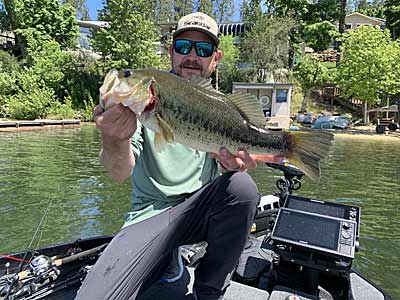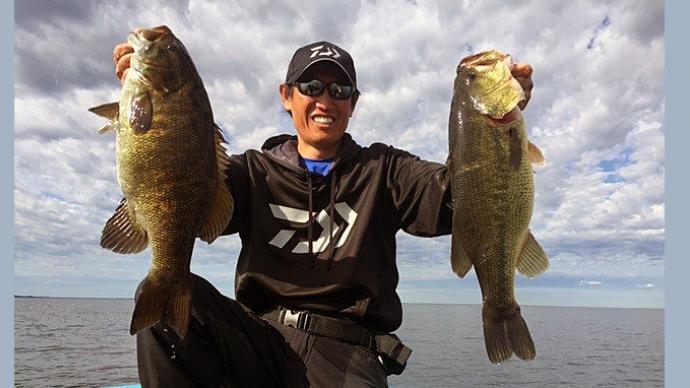
The drop-shot rig has gone from a fringe West Coast technique to a staple of bass anglers everywhere in the past two decades. The finesse technique has been catching fish for years from coast to coast and has spawned a whole category of technique-specific rods, hooks, weights, and different plastics to use with the rig.
The most common way to fish a drop-shot is with a finesse worm rigged on a small hook. This way works great, but there are plenty of alternative methods for drop-shot fishing.
Wacky-Rig Drop-Shot
Standard practice for drop-shot fishing is to hook a soft plastic bait right through the bait near the bait's top or nose. It exposes the hook and gives the bait great action, but wacky-rigging a bait changes everything.
For one, the bait's action is much different and wilder under the surface. It also allows the bait to fall slower, which can be a way to show the fish something different if everyone else is throwing the same nose-hooked drop-shot baits.
Since the action of a wacky-rigged bait is more aggressive, it generally works best in warmer water conditions. It also tends to work best in shallower water as the rigging method causes it to fall to the bottom slowly.
Short-Leader vs. Long-Leader
If you were to survey bass anglers on drop-shot leader length, the consensus would generally be in the twelve-inch range. It seems to be the average length used and is a great starting point. Adjusting your leader length to extremely short or extra-long can significantly impact your underwater bait performance.

A shorter leader three to four-inch leader gives your bait a much tighter action as you work your rod. This short leader also makes it an excellent choice for very shallow water or when the fish are focused on the bottom for their next meal. It also works well when fishing in cold water or when the fish are inactive.
On the other hand, a longer leader of 16-inches or more is a good choice when the fish are sitting up off the bottom. This can be seen by paying close attention to your electronics and how the fish are positioned. Realistically, a leader of up to 30-inches can be managed and will still allow you to cast the rig effectively.
With a longer leader, your bait will also perform much differently as the closer it is to your rod, the more action it will have, as each rod movement will be amplified more the closer the line is to the rod. This makes it a good choice for warmer weather and targeting more aggressive fish.
Swimming a Drop-Shot
A drop-shot rig is best worked slowly along the bottom-most of the time, but adding a small swimbait allows you to show the fish something new. A paddle-tail swimbait around three inches long can swap out standard finesse worms on your drop-shot, and the rig can now be fished right along the bottom with regular swimming retrieve.
The benefits of fishing a swimbait on a drop-shot instead of on a jighead are that the bait will remain in a fixed position. If your leader's length is twelve inches long, the swimbait will maintain that space from the bottom. When fishing a swimbait on a jighead, more work is required to keep it along the bottom instead of rising and falling in the water column, so the drop-shot solves the issue. This same approach can be made with other soft plastics as well.
Drop-Shot for Suspended Fish
This may sound counterintuitive, but fishing a drop-shot rig in the middle of the water column works. By nature, it is a rig that is fished along the bottom, but it can be equally effective for suspended bass.
The biggest key to fishing it this way is using your electronics, and it would be nearly impossible or ineffective if you were not watching your screen. The depth at which the fish are located in the crucial piece of the puzzle, and watching to make sure your bait is in front of the fish is vital.
Simply shaking the bait in place will give the bait the same action, whether it is suspended or sitting on the bottom. With today's advanced electronics and forward-facing sonar, you can watch the fish and how they interact with your bait sitting in front of them to adjust your shaking to trigger them to bite.

Flipping and Pitching a Drop-Shot
Most of the time, flipping and pitching are reserved for jigs or Texas-Rigged soft plastic baits. This is the norm and works well, but these techniques can also be done with a drop-shot, often called "Bubba-Shotting," which is flipping and pitching a drop-shot. This works exceptionally well in some situations.
Just upsize your hook, soft plastic, and line size compared to your finesse drop-shot rigs. It gives the fish a different look, and as long as you Texas-Rig the bait on your drop-shot rig, you can remain weedless and not worry about hanging up in wood or grass.
Big Bait Drop-Shotting
Not to be confused with "bubba-shotting," simply going to a bigger bait can sometimes make all the difference. One of the best drop-shot baits is a soft jerkbait.
A fluke-style bait looks like a large baitfish and looks like a bigger meal for a bass. Don't be afraid to use large soft plastics when drop-shot fishing.
The drop-shot rig is now a mainstay for bass fishing. The traditional way of fishing the rig with a finesse worm and slowly working it along the bottom will catch plenty of fish, but there are some tricks and alternative ways to fish a drop-shot that will expand the places and situations where you can fish it.




